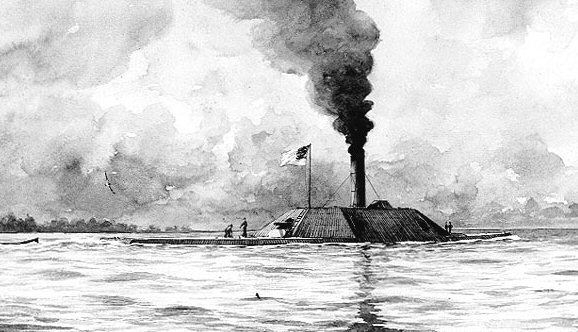 |
| Macomb, W.H., "Plan of Attack on the Albemarle" (first page), (NARA, RG 45) |
 |
| C.S.S. Albemarle (U.S. Naval Historical Center NH 57815) |
Following this encounter, a long period of inactivity began. Commander Macomb arrived in June to head up Union naval forces in the area. Over the ensuing months, he prepared for another possible sortie by the ironclad and, at some point, drafted the plan reproduced here. The scheme involves five Union gunboats - the Oswego, Mattabesset, Tacony, Shamrock, and Wyalusing - and is similar to one drawn up for the May 5th fight. See O.R.N. Ser. I, 9:735-736 (Captain Melancton Smith's plan). In both cases, the architects (Smith and Macomb) sought to overwhelm the Albemarle with a large number of wood-clad vessels. At the time, no Union ironclad could operate in Carolina's shallow sounds. Ultimately, Macomb did not get the chance to implement his plan because the Albemarle never emerged for battle again. Eventually, Union forces attacked Plymouth directly in October. In one of the war's storied raids, the intrepid Lieutenant William B. Cushing destroyed the ironclad at Plymouth. Days after Cushing's exploit, Macomb's force captured the town.
++++++++++++++++++
A-7
1864
W.H.M.
"Plan of Attack on the Albemarle"
(in case she comes out of the River)
Macomb Papers
Plan of attack
The
vessels are formed in the following order in line of battle – the Ram supposed
to be going to the right. No. 1.  |
| No. 1 (Detail), (NARA, RG 45) 1- "Oswego" 2- "Mattabesset" 3- "Tacony" 4- "Shamrock" 5- "Wyalusing" |
 |
| No. 2 (Detail) (NARA, RG 45) |
In case
the “Wyalusing” does not destroy the Ram with her torpedoes, the vessels will
pass round her (the Ram), again in the same line. When the Shamrock intends to ram, she will keep outside the line followed by the other vessels, so as not to
make too short a curve, and run into the Rebel, or hoisting the “Jack” at the
fore before so doing. If at night, she will hoist a white light. The position
of the fleet at the time will be seen in No. 3.
 |
| No. 3 (Detail) (NARA, RG 45) |
[Note to No. 3:] No. 3 “S” represents the position of the “Shamrock” when intending to ram. At other times her position is at 4.
The picket boats to keep out of action, but
near enough to render any necessary assistance. When signaled, they are
to come forward with a hawser and endeavor to foul the smokestack or propeller of the Ram.
Signals from the ship regulating
the speed of the fleet will be made by means of the steam whistle as follows:
1= “go ahead slow” - if going slow “go slower”
1= “go ahead slow” - if going slow “go slower”
2= “Stop”
3= Back
4= “go ahead fast” – if fast, "go faster"
4= “go ahead fast” – if fast, "go faster"